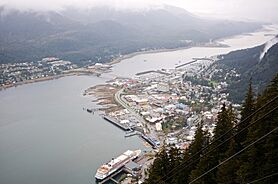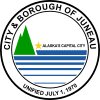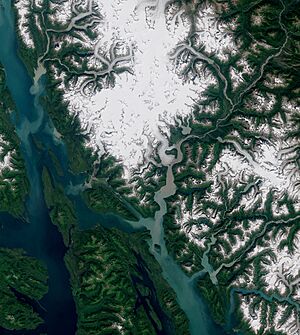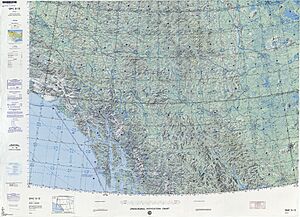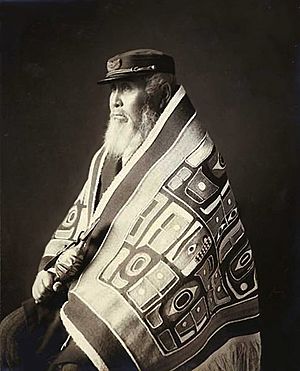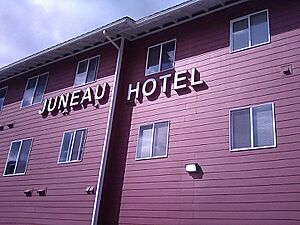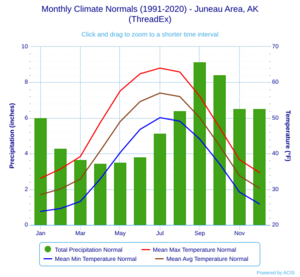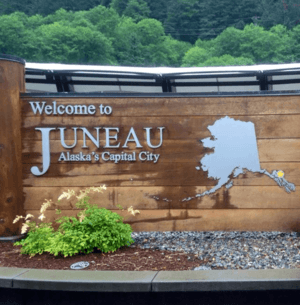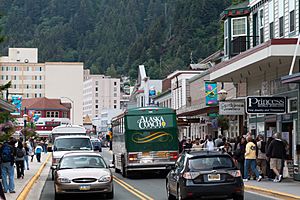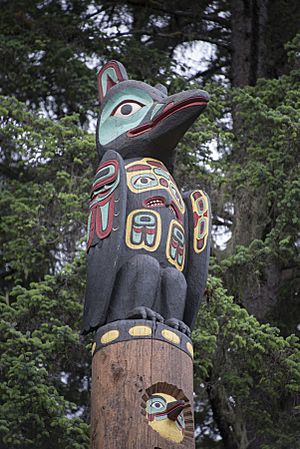Juneau, Alaska facts for kids
Quick facts for kids
Juneau
Dzánti K'ihéeni (Tlingit)
|
|||||
|---|---|---|---|---|---|
| City and Borough of Juneau | |||||
|
View of Juneau from the Goldbelt Tram. The Juneau–Douglas Bridge spans the Gastineau Channel
South Franklin Street
Downtown with Mount Juneau in the background
Valentine Building
|
|||||
|
|||||
| Country | United States | ||||
| State | Alaska | ||||
| Named | 1881 (Juneau City) 1882 (Juneau) |
||||
| Incorporated | 1900 | ||||
| Home-rule city | October 1960 | ||||
| Borough | September 30, 1963 (Greater Juneau Borough) July 1, 1970 (City and Borough of Juneau) |
||||
| Founded by | Richard Harris and Joe Juneau | ||||
| Named for | Joe Juneau | ||||
| Area | |||||
| • State capital | 3,254.70 sq mi (8,429.64 km2) | ||||
| • Land | 2,704.03 sq mi (7,003.41 km2) | ||||
| • Water | 550.67 sq mi (1,426.23 km2) | ||||
| • Urban | 14.0 sq mi (36 km2) | ||||
| Elevation | 33 ft (10 m) | ||||
| Population
(2020)
|
|||||
| • State capital | 32,255 | ||||
| • Estimate
(2022)
|
31,685 | ||||
| • Density | 11.93/sq mi (4.61/km2) | ||||
| • Urban density | 1,749.5/sq mi (675.5/km2) | ||||
| GDP | |||||
| • State capital | .4 billion (2022) | ||||
| Time zone | UTC−9 (AKST) | ||||
| • Summer (DST) | UTC−8 (AKDT) | ||||
| ZIP Codes |
99801–99803, 99811–99812, 99821, 99824
|
||||
| Area code(s) | 907 | ||||
| FIPS code | 02-36400 | ||||
| GNIS feature ID | 1404263 | ||||
Juneau (![]() i/ˈdʒuːnoʊ/ JOO-noh), officially called the City and Borough of Juneau, is the capital city of Alaska. It's located along the Gastineau Channel in the Alaskan panhandle. Juneau became the capital in 1906. The government moved here from Sitka, Alaska, as decided by the U.S. Congress in 1900.
i/ˈdʒuːnoʊ/ JOO-noh), officially called the City and Borough of Juneau, is the capital city of Alaska. It's located along the Gastineau Channel in the Alaskan panhandle. Juneau became the capital in 1906. The government moved here from Sitka, Alaska, as decided by the U.S. Congress in 1900.
On July 1, 1970, the City of Juneau joined with the City of Douglas and the surrounding area. This created the current "consolidated city-borough." This makes Juneau the second-largest city in the United States by land area. It is even bigger than the states of Rhode Island or Delaware.
Downtown Juneau is at the base of Mount Juneau. It sits across the channel from Douglas Island. In 2020, Juneau had a population of 32,255 people. This makes it the third-largest city in Alaska, after Anchorage and Fairbanks. Many cruise ship visitors come to Juneau from May to September. Over 21,000 people visit daily during these months.
The city is named after a gold prospector, Joe Juneau. It was once called Rockwell, then Harrisburg. The local Tlingit people call the town Dzántik'i Héeni. This means "Base of the Flounder's River."
Juneau is special because no roads connect it to the rest of Alaska or the United States. This is because of the very rugged mountains around the city. So, everything coming in or out of Juneau must travel by plane or boat.
Downtown Juneau is at sea level. It is surrounded by steep mountains that are about 3,500 to 4,000 feet high. On top of these mountains is the Juneau Icefield. This is a huge ice mass with about 30 glaciers flowing from it. Two glaciers, the Mendenhall Glacier and the Lemon Creek Glacier, can be seen from the local roads. The Mendenhall Glacier is slowly getting smaller.
The Alaska State Capitol building in downtown Juneau was built in 1931. It used to house federal offices and the territorial legislature. Today, it is where the state legislature meets. It also holds the offices of the governor and lieutenant governor.
Contents
History of Juneau
The Gastineau Channel was a popular fishing spot for the Auke and Taku tribes. These Native Alaskan groups lived in the area for thousands of years. The Auke people had a village and a burial ground here, known today as Indian Point. They would gather herring every year when the fish came to lay their eggs.
Today, the Auke people and the Sealaska Heritage Institute work to protect Indian Point. They see it as a sacred place because of the burial ground and its importance for gathering food from the sea. They still collect clams, sea urchins, and plants there. In 2016, Indian Point was added to the National Register of Historic Places.
Descendants of these Native cultures include the Tlingit people. Their cultures have rich artistic traditions. They are known for carving, weaving, singing, dancing, and storytelling. Juneau is an important center for the Tlingit, Haida, and Tsimshian people of Southeast Alaska.
Early European Explorers
The first European to see the Juneau area was Joseph Whidbey in 1794. He was part of George Vancouver's expedition. He explored the Gastineau Channel and noted that it was full of ice. The Russians had a colony in Alaska from 1784 to 1867. However, they did not settle in Juneau itself.
Gold Rush and City Naming
After the California gold rush, miners looked for gold in other parts of the West. In 1880, a mining engineer named George Pilz offered a reward. He wanted a local Native Alaskan to show him where gold could be found. A Native person brought him some gold ore.
Pilz sent two prospectors, Joe Juneau and Richard Harris, to the Gastineau Channel. They found large gold nuggets there. On October 18, 1880, they marked out a town site. Soon, a mining camp grew up. Many miners arrived quickly.
The camp became a village, mostly made of tents and shacks. It was the first European American settlement founded in Alaska after the United States bought Alaska. By late 1881, the village had over 100 people. It was first called Rockwell, then Harrisburg. On December 14, 1881, the miners decided to name the settlement Juneau, after Joe Juneau.
Russian Orthodox Church in Juneau
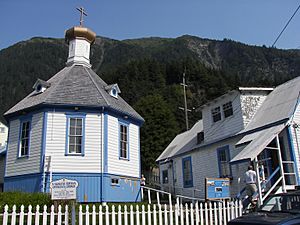
Some Tlingit people asked the Russian Orthodox Church for help. The church had been active in northern Tlingit areas since the early 1800s. One priest even translated religious texts into the Tlingit language. In 1890, about 700 people converted to the Orthodox faith.
The St. Nicholas Russian Orthodox Church was finished in 1894. It is still an important place for Tlingit, Serbian, and other Orthodox Christians in Juneau.
Mining Development and Capital Selection
Major gold mines in the Juneau area before World War II included the Treadwell Mine and the Alaska-Juneau Mine. By 1906, Juneau became the capital of Alaska. This happened because Sitka, the original capital, had become less important. Juneau was the largest city in Alaska between World War I and World War II.
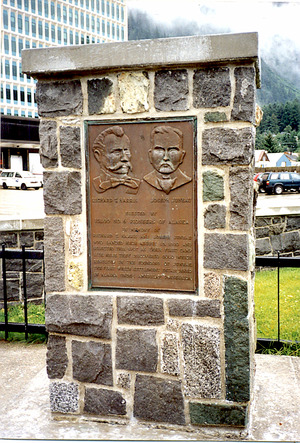
In 1911, the U.S. Congress approved money for a capitol building. Construction was delayed by World War I. Citizens of Juneau donated money to help buy the land. Building started on September 8, 1929. The capitol was finished in less than two years and opened on February 14, 1931. It was designed in the Art Deco style.
When Alaska became a state in 1959, the building became the Alaska State Capitol. The Alaska Governor's Mansion was built in 1912. It has ten bathrooms, six bedrooms, and eight fireplaces. It is the governor's home when they are in Juneau for official business.
During World War II, Japanese citizens and Japanese Americans living in Juneau were moved to internment camps. This was due to a government order. In 2014, the Empty Chair Memorial was dedicated in Juneau. It remembers the Japanese community that was forced to leave.
There have been many attempts to move the capital away from Juneau. People in Anchorage and Fairbanks wanted the capital closer to them. However, voters have always chosen to keep Juneau as the capital. The cost of moving the capital was too high.
In the 21st century, Juneau's population has grown slowly. Cruise ship tourism has increased a lot. In 1990, about 230,000 passengers visited. By 2006, nearly 1,000,000 visited. In 2023, this number reached 1.65 million. This tourism mainly happens in the summer.
In 2016, Juneau was temporarily renamed UNO for April Fool's Day. This was a promotion with Mattel, the company that makes the card game. Mattel donated $15,000 to a local foundation.
Geography of Juneau
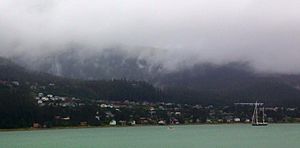
Juneau is a very large city by area. It covers about 3,255 square miles (8,429 square kilometers). This makes it the second-largest city in the United States by area. About 2,717 square miles (7,037 square kilometers) is land, and 538 square miles (1,393 square kilometers) is water.
The central part of Juneau is located at 58°18′00″N 134°24′58″W. The City and Borough of Juneau includes Douglas Island. This island is west of mainland Juneau. You can reach Douglas Island by crossing the Juneau-Douglas Bridge.
Juneau can be affected by natural disasters. In 2014, an earthquake caused power outages. In 2008, avalanches damaged power lines. This forced the city to use more expensive diesel generators for a month.
Juneau's Borders
Juneau shares its eastern border with the Canadian province of British Columbia. It is the only U.S. state capital that borders another country.
Protected Natural Areas
Juneau is home to parts of the Tongass National Forest. This includes parts of the Admiralty Island National Monument and the Tracy Arm-Fords Terror Wilderness. Alaska State Parks also maintains the Juneau Trail System. These trails range from easy to very difficult for hiking.
Juneau's Climate
Juneau has a mild and moist climate. This allows for the growth of temperate rainforests. Unlike many other parts of Alaska, Juneau does not have permafrost (permanently frozen ground).
Temperatures do not change much throughout the year. Winters are mild for Alaska, with January temperatures usually just below freezing. Summers are cool, but can sometimes get warm. Temperatures above 75°F (24°C) or below 10°F (-12°C) are rare.
It rains or snows on about 230 days each year. The average rainfall is about 62 inches (158 cm) at the airport. Most of the rain falls in the fall and winter. Snow usually falls from November to March.
The coldest temperature ever recorded in Juneau was -22°F (-30°C) in 1968 and 1972. The hottest temperature was 90°F (32°C) in 1975.
Juneau's Population
| Historical population | |||
|---|---|---|---|
| Census | Pop. | %± | |
| 1890 | 1,253 | — | |
| 1900 | 1,864 | 48.8% | |
| 1910 | 1,644 | −11.8% | |
| 1920 | 3,058 | 86.0% | |
| 1930 | 4,043 | 32.2% | |
| 1940 | 5,729 | 41.7% | |
| 1950 | 5,956 | 4.0% | |
| 1960 | 6,797 | 14.1% | |
| 1970 | 13,556 | 99.4% | |
| 1980 | 19,528 | 44.1% | |
| 1990 | 26,751 | 37.0% | |
| 2000 | 30,711 | 14.8% | |
| 2010 | 31,275 | 1.8% | |
| 2020 | 32,255 | 3.1% | |
| 2023 (est.) | 31,555 | 0.9% | |
| U.S. Decennial Census 2020 |
|||
Juneau first appeared in the U.S. Census in 1890. It became an official city in 1900. In 1970, Juneau merged with Douglas and the surrounding area. This caused a big jump in population between the 1970 and 1980 censuses.
In 2020, Juneau had 32,255 people. The city has a low population density, meaning people are spread out. The population is made up of many different groups. About 64.7% are White, 10.1% are Native American or Alaska Native, and 6.7% are Asian. About 14.3% are from two or more races. About 7.0% of the population is Hispanic or Latino.
The average household income in Juneau was $90,126. About 7.2% of the population lived below the poverty line.
Juneau's Economy
The main employer in Juneau is the government. This includes the state government, federal government, and local city government. The local government runs the airport, hospital, harbors, and school district. State government jobs make up about a quarter of Juneau's economy.
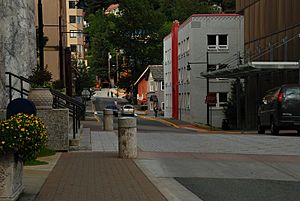
Tourism is a big part of the local economy, especially in the summer. In 2023, about 1.65 million cruise ship passengers visited Juneau. This creates many summer jobs in the city.
The fishing industry is also important in Juneau. In 2004, Juneau took in 15 million pounds of fish and shellfish. This was worth $21.5 million. Many commercial fishing boats sell their fish to plants in nearby towns. Juneau is home to many fishing associations.
Other local industries include real estate, highway construction, and mining. Alaska Seaplanes, an airline, has its main office in Juneau. In 2010, Juneau had 1,107 businesses. This means there are about 28 people for every business.
Juneau's electricity comes mostly from the Snettisham Hydroelectric Project. This facility is only reachable by boat or plane. The Marine Exchange of Alaska, a non-profit group, is also based in Juneau. They track vessels to keep maritime operations safe across Alaska.
Culture and Fun in Juneau
Juneau hosts several fun events each year. These include the annual Alaska Folk Festival and the Juneau Jazz & Classics music festival. Every two years, Juneau holds Celebration, a festival of Alaska Native culture.
The city owns a ski resort called Eaglecrest on Douglas Island. There is also a city-owned ice-skating rink called Treadwell. It is named after the Treadwell Gold Mine. The rink offers figure skating, hockey, and open skate times. In warmer months, it is used for rollerblading, tennis, basketball, and concerts.
Juneau has a lively performing arts scene. It is home to Perseverance Theatre, Alaska's largest professional theater. Other theater groups include Theatre in the Rough and Theater Alaska. The Juneau Symphony performs regularly. There are also two local opera companies. The JUMP Society shows short films made by local artists. Gold Town Nickelodeon is a local movie theater that plays independent and classic films.
Downtown Juneau has many art galleries. They take part in monthly "First Friday Art Walks" and an annual "Gallery Walk." The Juneau Arts & Humanities Council helps organize events and runs the Juneau Arts & Culture Center. The University of Alaska Southeast campus also hosts lectures and performances. The Sealaska Heritage Institute has a building with carvings and cultural exhibits.
Efforts to Move the Capital
There have been many discussions about moving Alaska's capital away from Juneau. The main reason is Juneau's remote location. In 1960 and 1962, voters said no to moving the capital.
In 1974, Alaskans voted to move the capital. The new location had to be within 300 miles of both Anchorage and Fairbanks. It also needed 100 square miles of donated public land. A committee suggested Willow, Alaska, and voters chose it in 1976. However, in 1978, voters rejected spending nearly $1 billion to move the capital.
Voters also passed a rule called the FRANK Initiative. This rule required all costs of moving the capital to be shown and approved by Alaskans. In 1982, voters again said no to spending about $2.9 billion to move the capital to Willow. This vote also canceled the earlier approval to move the capital.
In 1994, voters again rejected moving the capital to Wasilla. They also approved the FRANK Initiative again. In 2002, Alaskans voted against moving the capital once more. So, Juneau remains the capital of Alaska.
Notable People from Juneau
- Carlos Boozer (born 1981), professional basketball player
- Mike Dunleavy (born 1961), current governor of Alaska
- Janet Gardner (born 1962), singer of the hard rock band Vixen
- Charles Melton (born 1991), actor
- Joshua Morrow (born 1974), actor from The Young and the Restless
- Rie Muñoz (1921–2015), artist and educator
- Elizabeth Peratrovich (1911–1958), civil rights activist and Tlingit leader
Education in Juneau
Schools for Kids
Juneau is served by the Juneau School District. It includes several elementary, middle, and high schools:
- Sayéik: Gastineau Elementary School
- Harborview Elementary School
- Riverbend Elementary School
- Mendenhall River Elementary School
- Sítʼ Eetí Shaanáx̱ - Glacier Valley Elementary School
- Auke Bay Elementary School
- Juneau Community Charter School (kindergarten through eighth grade)
- Montessori Borealis School (preschool through eighth grade)
- Tlingit Culture Language & Literacy (kindergarten through fifth grade)
- Dzantik'i Heeni Middle School
- Floyd Dryden Middle School
- Juneau-Douglas Yadaa.at Kalé High School
- Thunder Mountain High School
- Yaaḵoosgé Daakahídi Alternative High School
- HomeBRIDGE (a homeschooling program)
There are also several private schools in Juneau:
- (Glacier) Valley Baptist Academy
- Faith Community School
- Thunder Mountain Learning Center
- Juneau Seventh-day Adventist Christian School
- Juneau Montessori School
Colleges and Universities
The University of Alaska Southeast is located in the Auke Bay community. It offers college degrees. The University of Alaska Fairbanks also has a campus in Juneau for students studying marine science.
Transportation in Juneau
Juneau is unique because you cannot drive to it from other cities. There are roads within the city, but no roads connect Juneau to the rest of North America. You can only get to Juneau by air or by sea. Cars and trucks are brought to Juneau by large boats called barges or by the Alaska Marine Highway ferry system.
-
View of downtown Juneau from the Juneau-Douglas Bridge. The bridge connects mainland Juneau with Douglas Island.
Travel by Sea
The state-owned ferry system is called the Alaska Marine Highway. These ferries connect Juneau to many other cities in Southeast Alaska. They also connect to the road system in Bellingham, Washington and Prince Rupert, British Columbia. High-speed catamarans, called "fast cats," also connect Juneau to Haines and Skagway much faster than regular ferries.
Travel by Air
Juneau International Airport serves the city. Alaska Airlines flies to Juneau all year round, with many daily flights. They connect Juneau to Seattle and Anchorage. In the summer, Delta Air Lines also flies to Juneau from Seattle.
Smaller airlines like Alaska Seaplanes and Ward Air offer charter seaplane service. They fly to smaller villages nearby and offer flightseeing tours.
Roads in Juneau
Building and maintaining roads in Juneau is difficult and expensive. This is due to avalanches, steep slopes, cold weather, and environmental concerns. The Juneau-Douglas Bridge connects mainland Juneau with Douglas Island.
No roads connect Juneau to the rest of North America. This is because of a huge icefield to the east. Also, glaciers block the route up the Taku River. Juneau is one of only four state capitals not served by a major highway.
Juneau Access Project
For many years, there were plans to build a road connecting Juneau to Haines and Skagway. This project was called the Juneau Access Project. It would have involved building a road and using a fast ferry. The project was estimated to cost hundreds of millions of dollars.
People in Juneau had different opinions about the road. Some thought it would help connect Juneau to the outside world and bring economic benefits. Others worried about the high costs and the impact on the environment. In 2016, the state decided not to support the project due to financial problems. The project was officially ended in 2018.
Public Transportation
Juneau has a local bus service called Capital Transit.
Walking, Hiking, and Biking
Many residents in Juneau walk, hike, or bike for fun and to get around. Downtown Juneau has sidewalks and outdoor stairs. Some roads have bike lanes, and there is a bike path along the main highway.
City Services
Healthcare
Juneau is mainly served by Bartlett Regional Hospital. This hospital also helps people from nearby remote communities like Hoonah, Haines, and Skagway. In emergencies, people from these towns are flown to the hospital by helicopter or air ambulance.
Utilities
Juneau's electricity is provided by Alaska Electric Light and Power Company. Water and sewer services are managed by the City and Borough of Juneau.
Juneau Media
Newspapers
Juneau's local newspaper is the Juneau Empire. It is published on Wednesdays and Saturdays. The Capital City Weekly is also published weekly. The University of Alaska Southeast has a college newspaper called The Whalesong.
Radio Stations
Juneau has several radio stations:
- AM: KJNO 630, KINY 800, KXXJ 1330
- FM: KTKU 105.1, KSUP 106.3, and KBJZ-LP 94.1
- Public Radio: KTOO 104.3, KXLL 100.7, and KRNN 102.7. These three are run by KTOO.
Television Stations
Juneau's main television channels are:
- KTOO (PBS)
- 360 North (Alaska's public affairs channel, run by KTOO)
- KATH-LD (NBC)
- KYEX-LD (CBS/MyNetworkTV)
- KJUD (ABC)/The CW/Fox)
Students at Juneau-Douglas High School produce a weekly TV newscast called JDTV News.
Sister Cities
Juneau has five official sister cities:
 Whitehorse, Yukon, Canada
Whitehorse, Yukon, Canada Saskatoon, Saskatchewan, Canada
Saskatoon, Saskatchewan, Canada Chiayi City, Taiwan
Chiayi City, Taiwan Vladivostok, Primorsky Krai, Russia
Vladivostok, Primorsky Krai, Russia Kalibo, Aklan, Philippines
Kalibo, Aklan, Philippines
See also
 In Spanish: Juneau (Alaska) para niños
In Spanish: Juneau (Alaska) para niños


